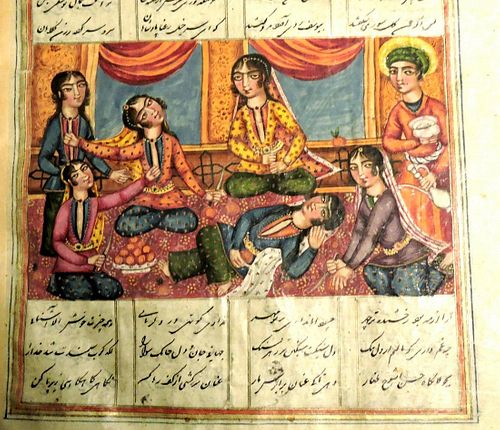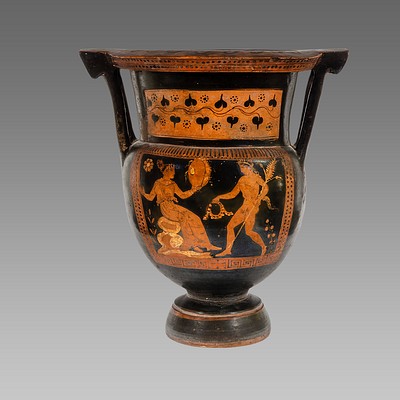A Voluminous Biographical Anthology, Titled Atashkadeh-ye Azar
Lot 414
Categories
Estimate:
$25,000 - $30,000
Absentee vs Live bid
Two ways to bid:
- Leave a max absentee bid and the platform will bid on your behalf up to your maximum bid during the live auction.
- Bid live during the auction and your bids will be submitted real-time to the auctioneer.
Bid Increments
| Price | Bid Increment |
|---|---|
| $0 | $10 |
| $100 | $25 |
| $500 | $50 |
| $1,000 | $100 |
| $5,000 | $250 |
| $10,000 | $500 |
| $20,000 | $1,000 |
| $50,000 | $2,000 |
| $100,000 | $2,500 |
| $200,000 | $3,000 |
About Auction
By Palmyra Heritage Gallery
Feb 28, 2021
Set Reminder
2021-02-28 11:00:00
2021-02-28 11:00:00
America/New_York
Bidsquare
Bidsquare : Antiquities, Islamic Art. Ancient Coins Sale
https://www.bidsquare.com/auctions/palmyra-heritage-gallery/antiquities-islamic-art-ancient-coins-sale-6430
Fine Collection of Classical Antiquities Greek Vases, Egyptian and Islamic Art & Ancient coins. from various estates. Palmyra Heritage Gallery info@palmyraheritagegallery.com
Fine Collection of Classical Antiquities Greek Vases, Egyptian and Islamic Art & Ancient coins. from various estates. Palmyra Heritage Gallery info@palmyraheritagegallery.com
- Lot Description
A Voluminous Biographical Anthology, Titled Atashkadeh-ye Azar (Azar's Fire Temple) by Hajji Lotf-Ali Beg Azar Bigdeli, better known as Azar Bigdeli ("Azar" was his pen name, 1722 – 1781).This dated and signed large-size anthology is adorned with nine gorgeous miniatures. There are two opening pages beautifully illuminated and decorated, in gold and colors in an arabesque design. It measures 9 x 12 inches. Number of folios 257 (514 pages). It is written in nasta`liq script, in black ink with titles and key sentences and words in red, mainly in four columns. All pages are ruled in several lines of gold, red, green, blue, and black. The columns are also ruled but in a different shade of gold.This particular copy was penned by the calligrapher Muhammad Baqir Ibn Hajji `Ali Saghir and completed on Wednesday the 10th of Safar of the Islamic year 1231, corresponding to 11th of January 1816 AD. It is known that Azar Bigdeli spend the last years of his life writing this anthology. He died in 1781 and the present copy was completed in 1816. There are 35 years between the author’s death and the writing of this copy. It is safe to say that this copy is one of the earliest of all other copies, if not the first copy, made of the original.The theme of fire is clearly borrowed from the Zoroastrian temple fire. Aside from his pen name and the title of his book, the work is divided into two majmaras (censers). All chapter are named with allusion to fire.Azar's teacher, Mir Sayyed Ali Moshtaq Esfahani (died 1757 or 1758), began a "literary return" movement (bazgasht-e adabi) to the stylistic standards of early Persian poetry. The Atashkadeh, like much other contemporary poetry from Isfahan and Shiraz, was an example of the bazgasht-e adabi of which Azar was a leading figure. The movement rejected what was considered excessive "Indian style" (sabk-e Hendi) in Persian poetry and sought, according to Ehsan Yarshater, "a return to the simpler and more robust poetry of the old masters as against the effete and artificial verse into which Safavid poetry had degenerated". Persian poetry, which originated during the Timurid period and was perfected in the courts of Mughal India, was called "Indian"; it later spread back to Safavid Iran and Ottoman Turkey, where it was prominent in the 17th and (to some degree) 18th centuries.The present anthology contains prose and verse, arranged in alphabetical order of the authors, a description of the poetic works of the kings, princes, emirs and poets of Iran, India and Central Asia as well as some geographical descriptions. The nine miniatures cover the themes that were close to the heart of Azar Bigdeli. They include the episode of Zulaykha and her maids cutting their hands while peeling oranges in a moment of bewilderment by discovering the dazzling beauty of Yusuf. Another painting shows Shirin on horseback meeting Farhad the sculptor with whom she fell in love with head over heels, as well as gallant or picaresque scenes, illustrating other poems. The manuscript is bound in contemporary polychrome lacquered papier-mâché binding. It is decorated with a usual theme Gul-o-bulbul (rose and nightingale) on a gold background,Azar was a writer and poet. He dedicated his anthology to the Iranian ruler Karim Zand (ruled 1751 – 1779)Azar's family was descended from the Bigdeli branch of the Turkoman Shamlu tribe. His ancestors moved from Syria to Iran in the fifteenth century and settled in Isfahan, where they served the rulers of Iran. Azar was born in Isfahan, the Safavid royal capital, during a time of chaos and instability. In 1722 (the year of his birth), the Safavid state had entered the final stages of collapse and the rebellious Afghans had reached Isfahan. Azar and his family were forced to move to Qom, where they owned property and where he lived for fourteen years. Around 1735 or 1736, his father was appointed governor of Lar and the coastal areas of Fars Province and Azar and his family moved to Shiraz (the provincial capital of Fars). In 1737 or 1738, after the death of his father, Azar made pilgrimages to Mecca and the Shi`ite shrines in Iran and Iraq. He then moved to Mashhad, where he enlisted in Nader Shah's army and accompanied his troops to Mazandaran, Azerbaijan, and Iraq. After Nader's death in 1747, Azar served his nephews and successors. When Karim Khan Zand ascended the throne, Azar decided to devote his time to scholarly pursuits and returned to Isfahan. He dedicated the present particular work to Karim Zand.Azar is principally known for his anthology, the Atashkadeh-ye Azar (Azar's Fire Temple), considered "the most important Persian anthology of the eighteenth century". Its chapter titles are based metaphorically on "fire". Azar dedicated the Atashkadeh-ye Azar, completed shortly before his death, to Iranian ruler Karim Zand. Although the work primarily deals with poets, it also contains information on the history of Iran since the Afghan invasion of 1722, a brief autobiography and a selection of Azar's poems.When Isfahan was sacked in 1750, a number of Azar's early poems were destroyed. However, he was still a respected poet during his lifetime.
- Shipping Info
-
SHIPPING FEES are the responsibility of the buyer. We can handle most of the shipping of the items we are selling, or we can recommend a local UPS Store to Handle it. All buyers will receive an invoice detailing their purchases, sales tax (if applicable), buyer's premium, and shipping/insurance charges. Items will be shipped only upon receipt of payment in full and will be insured for their full value. For shipments outside of the USA, customs and duties may apply upon entry in to host country, and this fee, if any, is the buyer's responsibility. We will not falsify customs value on international shipments! If you have questions about this, please inquire before bidding.
-
- Payment & Auction Policies
-
Available payment options
-
- Buyer's Premium



 EUR
EUR CAD
CAD AUD
AUD GBP
GBP MXN
MXN HKD
HKD CNY
CNY MYR
MYR SEK
SEK SGD
SGD CHF
CHF THB
THB



















